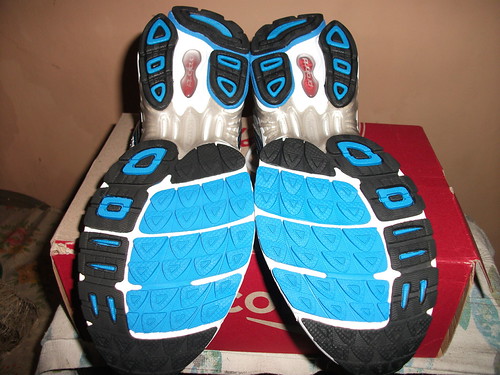BACKGROUNDER:
NEUTRAL CUSHIONING SHOE
- Recommended for neutral runners to slight overpronators who want a high-performance ride and maximum versatility of high-speed training to week-end high-mileage runs.
- Excellent shoe for heel or midfoot strikers that offers a soft cushiony transition ride from heel to toe-off
- Uses Wave Plate cushioning instead of a midsole foam for greater shock absorption and easy toe-off
- Weight: 12.8 Oz.
This is the first time for me to review a pair of Mizuno running shoes although i own old pairs of their Wave Elixir-2 and the Wave Precision-9, the latter which i purchased about 3 years ago. I like the Wave Elixir model very much as it was light and responsive while the Precision-9 did not perform as well as its midsole outlived its use faster than the life of its outsole. Both were very durable, though those were the last pairs of Mizuno i bought since then.
Last week, i was pleasantly surprised to hear from Timmy (of Mizuno Philippines) that we were finally going to test-run their newest model, the Mizuno Wave Prophecy which had been advised to us of its pending release since last year.
CONSTRUCTION:
The Wave Prophecy is a massive piece of engineering, with a bridge-like plastic plate that extends from the heel up to the toes of the sole. These plates called the Infinity Wave Plates are two inter-connected plates, stacked together and molded at different densities. It acts like an energy return system that absorbs shock, maintain stability and pushes off efficiently.
The overlays are properly positioned, the heel counter well padded and the stitching are well done. The soft inner mesh are designed with red, black and white color strips and they did a good job in showing some flair in the over-all aesthetics of the shoe.
The outsoles are fairly aggressive that would work well on many surfaces. Also, the sock-fit insoles are removable, conforms with the shape of the foot and is well cushioned.
FIT AND FEEL:
Do not be disheartened if you can’t get into the shoe on your first try. The shoe seems to be narrow that you couldn’t slide your foot easily inside. This is because the tongue has two garter stretch connected at each side to the base of the underfoot that may block the foot when sliding in. The trick is to pull the tongue up while slipping your foot into the shoe.
Personally, i would have preferred to do without those elastic garters and instead, have those lace-on eyelets on top of the tongue, as with many regular shoes.
The arch seems to be a little narrow and too controlling–maybe the result of the garters securing the foot snugly. Thank God the forefoot space is accommodating enough. Also, you could physically feel a lump of cushioning in the ball of the foot which is likely brought about by the addition of the AP+ insert located at the side of the forefoot.
PERFORMANCE:
Scheduling a run amidst a brewing typhoon would not be an ideal time to test run a new shoe but still, i wanted to be done with my first impressions. And true to my fears, it began to rain lightly just after the 3km mark so i had to stop at a nearby shed as i didn’t want to get my shoes wet this early! (Ugh..nice timing!) Luckily, the rain stopped after a few minutes so i continued my run. I was scheduled to do a 16k run.
The first 3 kms was an easy run and immediately, i noticed the comfort, starting with the soft landing on the heel and continuing with a smooth roll-through to the forefoot. Although the shoe, at 12.8 oz was mid-heavy, the ride was plush, insulating and particularly soft in the midfoot.
At times, the shoe felt bouncy but its surprisingly stable enough even when charging up on hilly terrains. Though it was not as light as i wished it to be, the Wave Prophecy was responsive, specially in the midfoot and forefoot and nimble enough that i thought would be ideal for really long runs.
When the rain started to pour on during the last 3 kilometers, the shoe maintained its agility but like any shoe that have been drenched by continuous rains, i had to drag it along as it became heavy with water.
CONCLUSION:
- The Wave Prophecy does serve up an ultra-smooth ride in a package that blends soft cushioning with a slight amount of stability. It would be an ideal everyday trainer, able to cover long distances or shorter, fast work-outs.
- I like the heel to toe transition of this shoe, noting the cushioned heel strike to the stiff yet soft toe-off which seem effortless.
- This shoe is on the heavy side but that’s counter-balanced by the easy flexing smoothness of the forefoot and its ability to glide easily to faster speeds when necessary.
- The full-length Wave Plate, the Dymotion Fit materials that shrinks and expands with your foot and the great looking aesthetics of the shoe do their job well and are all winners!
I’m looking forward to running more miles in them and hopefully, on dry weather!



































